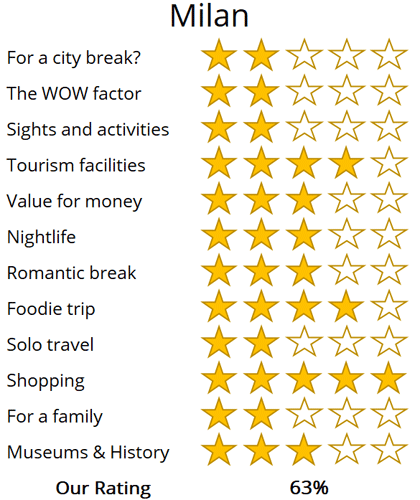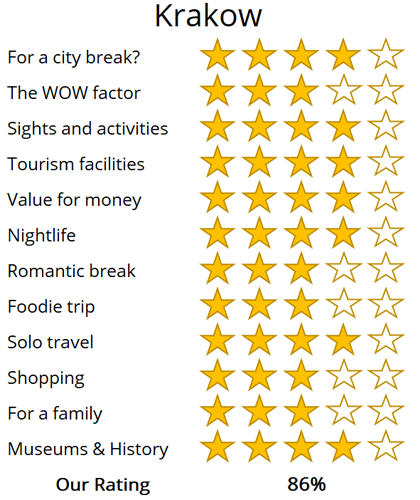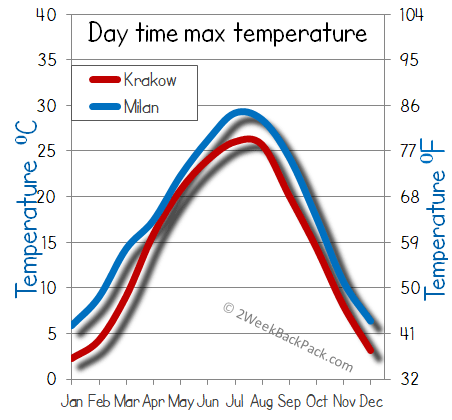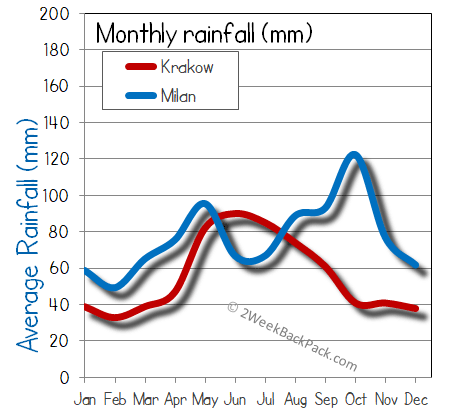WhereToGoForMyHoliday.com
The best destination comparison site!
WhereToGoForMyHoliday.com
The best destination comparison site!
Krakow or Milan, which is better for your holiday in 2024?
Krakow and Milan both offer unique and enticing experiences, but which one should you choose for your city break or holiday?
We recognise the difficulty in making this decision. While there is abundant information available on both destinations, clear guidance on which city better aligns with your travel preferences is often hard to find.
This article aims to provide an impartial comparison,and hopefully help you to choose the best city to visit.
The article is structured into several sections, each of which can be directly accessed through the following links:
• Introduction to the cities
• Scores and ratings
• Which one should I, friends, or family visit?
• When to visit and weather
• Who is the city suited for?
• The perfect 48hours (with map)
• Tourism details (where to stay? airport details?)
Introduction to Milan and Krakow
Krakow is Poland's cultural capital, one of the few cities in Central Europe to have emerged largely unscathed from the Second World War It is famed for its delightful Old Town, with cobbled alleys, centuries-old palaces and medieval castles.
But history aside, Krakow is also very much a lived-in city. Throw in leafy parks, bohemian districts, cutting-edge art galleries, and alluring nearby mountain ranges and it's easy to see why Krakow remains such a popular destination.
Milan, synonymous with fashion and luxury shopping, is a city where appearances matter, and even its main tourist attraction, the Galleria, is a shopping arcade. While the historic centre is home to high-end boutiques and designer stores, the city’s more creative and edgy districts can be found on the outskirts.
Visitors should be aware that Milan that Milan does not have the breadth of monuments and standout tourist attractions as of other Italian cities. This is primarily a business focused city, which reveres in sophistication and looking good.

The gothic Duomo in central Milan – a highlight is the view from the roof

The Rynek Główny is the main plaza of Krakow, and standing at the centre is the impressive Bazylika Mariacka (Saint Mary’s Basilica)
High-level summary for Krakow and Milan
Summary
Where would I journey for a personal escape?
Krakow
Where would I send my parents for a memorable visit?
Milan
Where's the ideal destination for my adventurous 19-year-old cousin?
Krakow
Where should my food-obsessed friend indulge their culinary passions?
Milan
Note: The above comparisons are weather-independent and are based on travel during the most opportune times of the year. Details about the ideal travel seasons are elaborated upon later in this article.
In the sections that follow, you'll find a comprehensive comparison between these two fascinating cities. This includes recommendations on the duration of stay, the best times to visit, and tailored 48-hour itineraries for each city.
The final segment delves into practicalities for your travels, such as the best airport to fly into, the optimal districts for your accommodation, and insider tips, for when you come to explore the city.
We hope that you find all of this information useful, in planning your next exciting trip!
Destination details
How long to spend each city?
The main sights of Milan can be easily seen in a single day of sightseeing.
A second day allows time to explore the more atmospheric districts (Navigli, Zona Tortona) or provides extra time for shopping.
To capture the essence of the city, you need to experience the early evening drinks culture and the evening strolls where everyone wears their finest clothes. Milan may lack many tourist sights, but there surrounding region certain compensates with many enjoyable day trips.
This includes the historic towns of Bergamo, Brescia and Pavia, the beautiful lakes of Garda, Maggiore and Como, plus the Italian Alps. It is even possible to visit Verona as a day trip.
In many ways, Krakow is the perfect example of a city-break destination. Not only is it compact and walkable, but its main-see sights are all connected via leafy parklands or riverside paths. You can check off the castle, the Old Town, the Jewish Quarter, and plenty more in a mere 48 hours. And the airport hosts oodles of low-cost flight links to cities right across Europe, which makes it easy to whiz in for just a couple of days.
If you're looking to add excursions (and there are loads of them) to your itinerary, you might need a little longer. Trips to Auschwitz, the salt mines in Wieliczka, and the Tatra Mountains can be crammed together in a single two-day tour, but it's better to do them separately and leave at least a day for each.
What's more, the wild Krakow nightlife might just put you out of action for a morning. Those with a penchant for vodka might be better off planning 4-5 days at least in the Polish city of kings.

The Naviglio Grande canal runs through the heart of the Naviglio district

The extensive history of Wawel Castle is reflected in the numerous architectural styles, there are baroque renaissance and ancient medieval found within this wonderous castle
For the real Milan experience, you want to visit during the summer or winter fashion weeks (Sep/Oct or Feb/Mar), to mingle with models, stylish and Aficionados.
For a city break, Milan is almost year-round, but it is cool and possibly wet in the winter, while in hot August most residents head to the beach for the whole month.
One of the quirks of Milan is at the weekends, most of its affluent or mobile residents leave the city for the coast (summer), the Alps (winter) or lakes (Spring/Autumn), leaving the city to tourists and foreign shoppers.
Summertime sees Krakow fill to bursting with tourists. It's the peak season, and things can get rammed on the main drags of the Old Town. That's why it's often better to try to come in months like May or September. Those are outside of major European vacations. There will be way fewer people queuing for the Wawel Castle. Hotel prices in Krakow also tend to drop considerably after August, while the Tatra Mountains are at their most handsome in spring and autumn.
Krakow in the winter is a totally different beast. Woolly jumpers, thermal underlayers, snow boots – you'll need the lot. Temperatures in south Poland can ebb to minus 25 degrees in the height of the season. However, the Planty Park and the Old Town do look truly stunning under a layer of snowflakes. It's also the time of year to plan ski trips near to Krakow. Just beware that pollution can be bad in the centre – the winter smog is some of the worst on the continent.
Krakow's a seriously versatile travel destination. Weaving the threads of a long, regal history together with a vibrant café culture, the culinary delights of Lesser Poland, and a nightlife that's nothing short of legendary, there's something in these parts to cater to all sorts. First up: Backpackers. The younger, budget-conscious crowd enjoy more hostel dorms and happy-hour deals than they can shake a Polish blood sausage at. Meanwhile, districts like Kazimierz are laden with concept stores and hip coffee shops.
Those who lean towards the more cultural side of things are also in luck. UNESCO World Heritage Sites abound in this part of Europe. In fact, Krakow's Old Town itself is one, bursting with medieval trading halls, brick-fronted churches, and castles that date back to the 1200s. There's also art by Leonardo da Vinci and Polish masters to get through in the museums, along with archaeology expos of the urban underground that are truly fascinating.
Being stuck between the vast plains of central Poland and the Carpathian Mountains means that Krakow is probably not the city for anyone looking for sun, sand and sea. What's more, the air quality is abysmal, so don't come expecting a break from life in a metropolis.
If you have a passion for fashion, a flair for style, and are willing to indulge in a premium experience, Milan is your destination. The city stands out for its high-end designer shopping, trendsetting fashion, and its overall chic aesthetic.
However, some visitors may find Milan less captivating compared to the grandeur of Rome, the cultural richness of Florence, or the picturesque scenes of Venice. Milan is predominantly a business hub, where the hardworking ethos of its inhabitants is reflected in its cutting-edge fashion and refined nightlife.
Insight: There are few historic buildings in Milan, as many were destroyed by the extensive bombing of the second world war.

The distinctive Castello Sforzesco castle in Milan

The Kościół św. Józefa (Saint Josphes church) in the Podgórze district, was inspired by gothic desings but only dates from 1909
48 hours in Milan
The interactive map below shows a suggested tour for 48hours in Milan. The first day is shown in green and the second day is marked in yellow.
Day 1: Start your first day at Piazza del Duomo, the vibrant heart of Milan. This square is home to the stunning Gothic Duomo di Milano cathedral (be sure to visit the roof for spectacular views) and the elegant Galleria shopping complex, which houses a range of boutiques and high-end retailers. On the other side, you'll find the Palazzo Marino and the prestigious Teatro alla Scala.
In the afternoon, take time to explore the area around the Sforza Castle and Parco Sempione. Make sure to visit the Santa Maria delle Grazie convent, where you can admire the renowned “The Last Supper” fresco. Later, explore the fashionable Brera district, known for its blend of luxury stores and stylish residents.
Early evening is when Milan truly comes alive. As the workday ends, locals flock to bars for Apericena (a happy hour accompanied by a light buffet), where they enjoy fine cocktails and showcase the latest fashion trends. The Navigli district is an excellent spot to immerse yourself in this contemporary cultural tradition.

The Santa Maria delle Grazie convent, the location of one of the most controversial religious paints….
Day 2: For your second day, take a stroll from the Duomo, along the lively Via Torino, and continue onto Corso di Porta Ticinese, passing the impressive Basilica San Lorenzo Maggiore before entering the vibrant Navigli district. This canal-lined quarter brims with artisanal shops, trendy bars, and is a popular haunt for the city's youthful population.
The canals and train lines mark the boundary between Navigli and Zona Tortona, a district that has transformed from its gritty past to become Milan's hub of design and creativity. Today, designers breathe new life into former warehouses, creating the latest fashion trends. The area is subtly cool and epitomises the determination and fervour of Milan's residents.
For football enthusiasts, a tour of the iconic San Siro stadium is a must on your second day in the city.
Related articles: 48 hours in Milan

San Siro stadium, home to two of Italy’ greatest football teams
48hours in Krakow
It's a good idea to stick to the city of Krakow itself for your first 48 hours. That's where you'll be able to uncover the rich medieval history, tales of Polish kings and queens, and some of the best dining (and drinking) the country has to offer:
Day 1: Where better to start than the UNESCO-tagged heart of Krakow? The Old Town is the piece de resistance here. Begin on the Market Square. It's one of the largest urban squares in the world, and a lively gathering point for both people and sights. On its eastern side is the wonderful Basilica of St Mary, arguably the most important church in Poland. The Cloth Hall (a stunning Renaissance building) stands in the middle, filled with souvenir stalls.
After learning about powerful kings and battles with Tartar hordes, you'll finish under the mighty Wawel Castle. That's an icon of Krakow. Walk through its gateways to find a green courtyard with a small café. Glug a coffee and then scale the belfry of on-site Krakow Cathedral for sweeping panoramas of the Vistula River and the Tatra Mountains (on a clear day).
For the evening, return to the Market Square and hit the local bars with fellow travellers.

Tourist boats moored along the banks of the Vistula River in the scenic Kazimierz district of Krakow
Day 2: A hangover-cure breakfast (if required) in Milkbar Tomasza complete with traditional Polish sausage starts the day. From there, head to the Planty Park. A famous green space, it follows the route of the old city walls and is a people-watching paradise. Move south to the district of Kazimierz. Known as the Jewish Quarter, it's got centuries-old synagogues and some of the coolest cafes in town.
An optional walking tour here is for you if you want to delve into the darker history of Krakow's wartime past. If not, stroll to the Vistula Boulevards to join the joggers. Then, it's easy to cross over to Podgorze neighborhood and find corner cafés and wine bars. For sunset, push southwards to the Krakus Mound. This off-the-beaten-track spot is great when the light dips low over the city.

Krakus Mound, at 270m high provides the best location to watch the sunset over Krakow
Krakow's transportation system is really efficient. A combo of buses and trams, it uses an integrated ticketing system. You can pay your fare at machines located at most stops, or on most trams themselves.
Contactless payment is generally accepted, but it's always a good idea to have the right change handy. You'll pay 5 PLN for a standard hour-long ticket and 3,20 PLN for a 20-minute ticket. Remember to validate that when you board!

The Sukiennice (Cloth Hall) was historically the commercial hub of Krakow
The Balice International Airport is the main gateway to Krakow from the air. Getting to and from the terminal is now really easy thanks to a dedicated train line that runs every 30 minutes or so to the central station. You can purchase your ticket at the airport platform or on the train (9 PLN). A taxi from the airport typically costs around 50-100 PLN, depending on the company you go for (Mega and Eco taxis are usually the cheapest).
Most of Krakow's hotels can be found at least within walking distance of the Old Town. Generally speaking, the closer you are to that the better. However, you might also prefer the café scene and more local atmosphere of Kazimierz, which sits just a little to the south.
Krakow is generally safe for visitors. Reports of bar scams (when staff charge astronomical rates for just a few beers) and taxi scams are occasional. Also be warned that Police will pounce on anyone caught drinking alcohol in public or crossing the road on a red light (both warrant a fine).
There are three airports for Milan; Linate (small dated, 7km to centre), Malpensa (main international airport, 50km from west of Milan) and Bergamo (Ryan air hub, 50km from north east of Milan). There is a bus from Bergamo to Milan (60minutes €6.00), train from Malpensa airport (50minutes €13.00) and from Linate just take a taxi (€12-15). There is no shortage of flights and departures to or from Milan, and fares, if booked far enough in advance, can be very cheap.
Milan has ample hotels and accommodation options, but these obviously need to be booked far in advance during the two fashion weeks. For your first visit you would want to be based close to the historic centre (Centro Storico) or for a more lively and authentic experience the Navigli district. For cheaper accommodation look to the Citta Studi, the main student area of the city. Milan has very good public transport, and is easy to travel around the city.

The Arco della Pace, in Milan
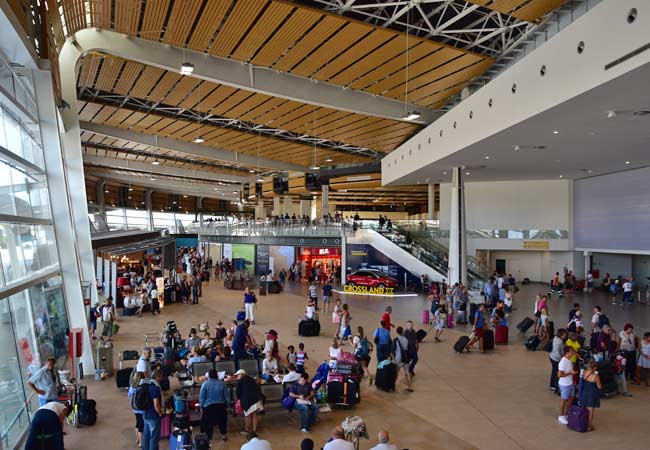
oh we were stuck in the airport!

Copenhagen was a bit expensive...

All we did was drink beer in Brussels...
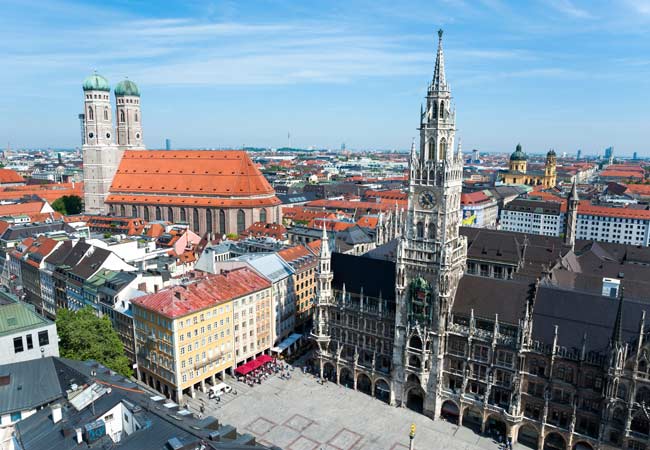
Muncih was crazy
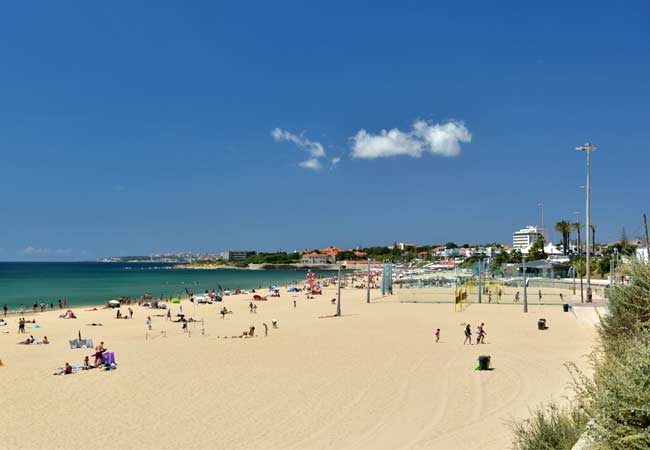
And we got so burnt!
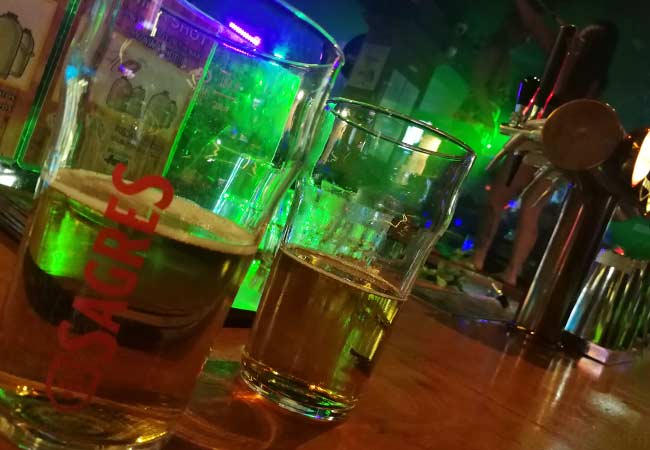
Remeber that night in Rome

oh we were stuck in the airport
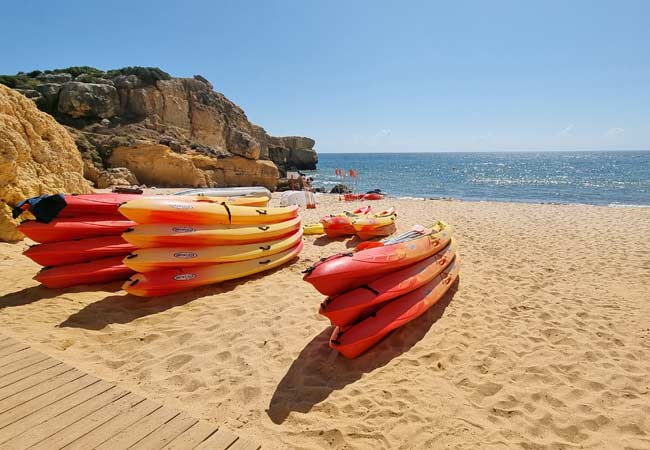
So much fun kayaking

Berlin and that group from Austria!

There was such a view from that church

And we got so burnt!

Munich was eventful, wasn't it!

Such a view from that cathedral in Florence
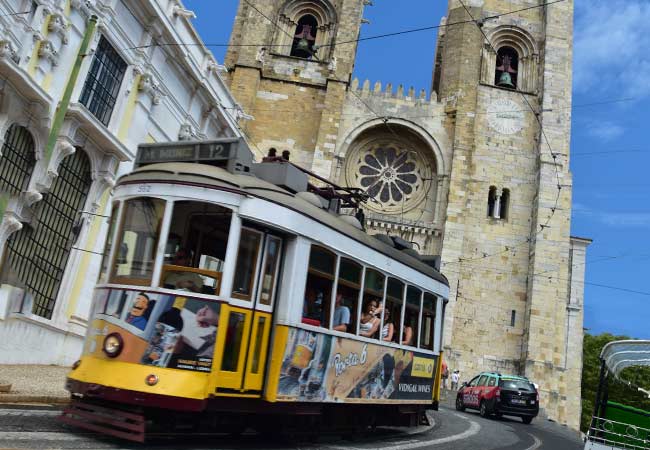
Lisbon was such so much fun

Last summer was so much fun .... x

Remeber that night in Rome

Lisbon was such so much fun

Such a view from that cathedral in Florence

Munich was eventful, wasn't it!

And we got so burnt!

Remeber that night in Rome

All we did was drink beer in Brussels...

Berlin and that group from Austria!

Can't wait to go back to Dubrovnik

Remember that boat ride in Prague

Copenhagen was a bit expensive...
